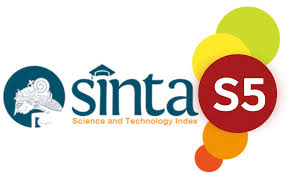Analisis Faktor–Faktor yang Berhubungan dengan Penerapan Organisasi Pembelajar
DOI:
https://doi.org/10.35446/dayasaing.v3i1.76Keywords:
learning organization, organization culture, senior management commitments, manager skill, employee attitude, organization of work, and human resources.Abstract
Abstract: The objectives on this research are to analyze the relationship between organization culture, senior management commitments, manager skill, employee attitude, organization of work, and human resources as a successful learning organization at PT. Bank Riau Kepri. The research population was 276 employees at the main office of Bank Riau Kepri Pekanbaru and the research samples were 73 employees at the main office of Bank Riau Kepri Pekanbaru from all level and division. A quota sampling was conducted to 73 employees. The primary data collection was conducted by distributing questionnaires and respondents’ responses measured using Likert Scale. Descriptive statistics analysis and inferential statistical analysis (partial correlation and multiple linear regression) were used to analyze data in this research. This research’s result shows that there is a positive relationship between organization culture, senior management commitments, manager skill, employee attitude, organization of work, and human resources as a successful learning organization.
References
Bungin, B. (2004).Metodologi Penelitian Kuantitatif Ed.1. Kencana, Jakarta.
Chong, S.C and Choi, YY.S. (2005). Critical Factors In The Succesful Implementation of Knowledge Management. Journal of Knowledge Management Practice. California State University, USA.
Cooper, D.R and Schindler, P.S. (2011). Business Research Method. 11th Edition, McGraw Hill Higher Education. New York, USA.
Darami, A. (1998). Learning Organization Practices: A Profile of SKF Bearing Industries (Malaysia) SDN. BHD.A Thesis. Universiti Putra Malaysia, Malaysia
Dymock, D and Mc.Charty, C. (2006). Towards a learning organization? Employee perceptions.The Learning Organization Vol. 13, No. 5. pp 525-536.Emerald Group Publishing Limited. www.emeraldinsight.com
Edmonson, A and Moingeon, B. (1996). From Organizational Learning to Learning Organization. Essential Readings in Management Trainings. Pp 21-34
Edmonson, A and Moingeon, B. (1996).Learning Organization and Competitive Advantage.Biddles Ltd, Guildford, Surrey, Great Britain.
Garvin, D.A. (1993). Building Learning Organization.Harvard Business Review 71, No.4. pp 78-91. Hardvard Business School Press, Boston. MA.
Garvin, D.A. (2000). Learning in Action: A guide to putting the learning organization to work. Hardvard Business School Press, Boston. MA.
Hofstede, G. 1986, Culture’s Consequences, International Differences in Work – Related Values. Sage Publication, Beverly Hills/London/New Delhi.
Hoon, J.S. (2008). The effect of learning organization culture on the practices of human knowledge – creation: an empirical research study in Korea. International Journal of Training and Development 12:4
Hoon, J.S, Joo. B and J, T.C. (2009).The dimension of learning questionnaire (DLOQ): A Validation Studyin a Korean Context. Human Resource Development Quarterly 20, No. 1 pp 43-61. Willy Periodicals, Inc.Published online in Wiley InterScience (www.interscience.wiley.com)
Jogiyanto.(2010). Metodologi Penelitian Bisnis. BPFE, Yogyakarta.
Juceviciene, P and Leonaviciene, R. (2007).The Change of Human Resource Development Concepts in the Process of Becoming a Learning Organization. Journal of Economics and Management 12 pp 569-575. Kaunas University of Technology. Lithuania.
Kline, P and Saunder, B. (1993).Ten Steps to a Learning Organization.Great Ocean Publishers, Arlington, Virginia.
Malhotra, Y. (1996). Organizational Learning and Learning Organizations: An Overviewhttp://www.brint.com/papers/orglrng.htm
Marsick, V.J and Watkins, K.E. (2003). Demonstrating the value of an organization’s learning culture: the dimension of the Learning Organization Questionnaire, Advances in Developing Human Resources, Vol. 11 No. 2. Downloaded by Ramesh Srinivashan from http://adh.sagepub.com
Marquardt M.J. (2002). Building the Learning Organization: A Systems Approach to Quantum Improvement and Global Success second edition. Mc Graw – Hill, London.
Mishra, B. and Uday, A.B. (2010).Empowerment: A necessary Attribute of A Learning Organization?.Organizations and Markets in Emerging Economies, Vol.1, No.2. pp 48-70. Asia Pacific Institute and International Management Institute, India
Pailis, E. A., & Suroto, B. (2016). The Influence of Partnerships and Self-concept for the Courage to Take Risks and Their Impact on the Achievements Sought of Small Industries in the City of Pekanbaru. American Journal of Economics, 6(5), 262-269.
Pedler, M., Burgoyne, J.D and Boydell, T. (1991).The Learning Company. Mc Graw – Hill, London.
Priyatno, D. (2010). Teknik Mudah dan Cepat Melakukan Analisis Data Penelitian dengan SPSS. Gava Media, Yogyakarta.
Putri, A.U. (2009). Identifikasi Penerapan Model Sistem Organisasi Pembelajar pada PT. TASPEN (Persero) Cabang Bogor.Skripsi.IPB, Bogor.
Rijal, S. (2009).Leading the Learning Organization.BusinessEducation and Acreditation, Vol.1 No.1. Purbanchal University, India.
Robbin, S.P. (1997). Perilaku Organisasi Buku 1. Salemba Empat, Jakarta.
Sambrook, S. (2002).Factors Influencing Learning in Work: A Comparison of Two Research Projects (European and United Kingdom – Based,EuropeanEducational Research Journal, Vol.1, No.3 pp 552-537. University of Wales, Bangor.UK.
Schein, E. (1990). Organizational Culture.American Psychologist, Vol. 45, February, pp.109-19.
Sekaran, U. (2003). Research Methods ForBusiness, 4th Edition. John Wiley and Sons, New York
Senge, P.M. (1990). The fifth disciplines: the art and practice of the learning organization. Doubleday Currency, New York.
Singh, K. (2010). An Analysis of Relationship between the Learning Organization and Organization Culture in Indian Business Organization.Organizations and Markets in Emerging Economies 1, No. 1 pp 142-165.University of Delhi, India.
Skennar, A. (2009). Establishing and Building a Learning Culture in an Organisation. Training & Development in Australia.
Sudharatna, Y. and Laubie, Li. (2003).An Organization’s Readiness to Change towards the Development of a Learning Organization.Organizational Learning and Knowledge,5th International Conference. Australia.
Sugiyono (2010).Statistika Untuk Penelitian. Alfabeta, Bandung.
Watkins, K.E and Marsick, V.J(1999).Dimension of the Learning Organization Questionnaire.Jossey – Bass, San Fransisco, USA.
Yang, B., Watkins, K.E and Marsick, V.J. (2004).The Construct of the Learning Organization: Dimensions, Measurement, and Validation. Human Resource Development Quarterly15, No. 1 pp 31-55.
Yohana, S.L dan Fitriati, R. (2009).Pengaruh Organisasi Pembelajar terhadap Kompetensi Pegawai Bank.Bisnis dan Birokrasi,Jurnal Ilmu Administrasi dan Organisasi Vol.16, No.1 hlm 25-35.










